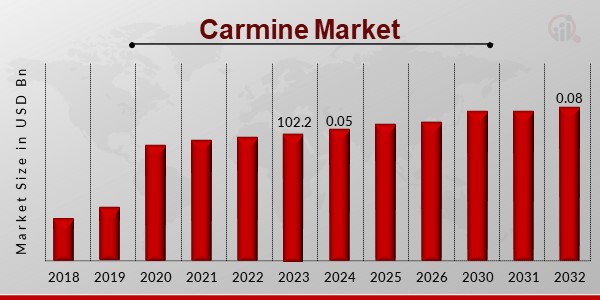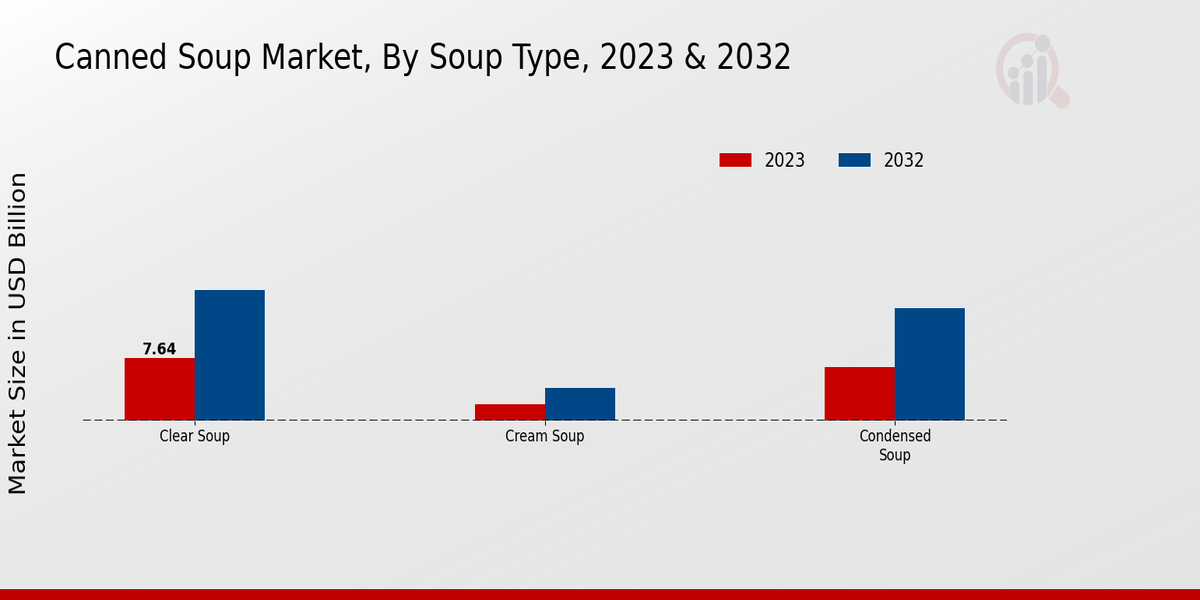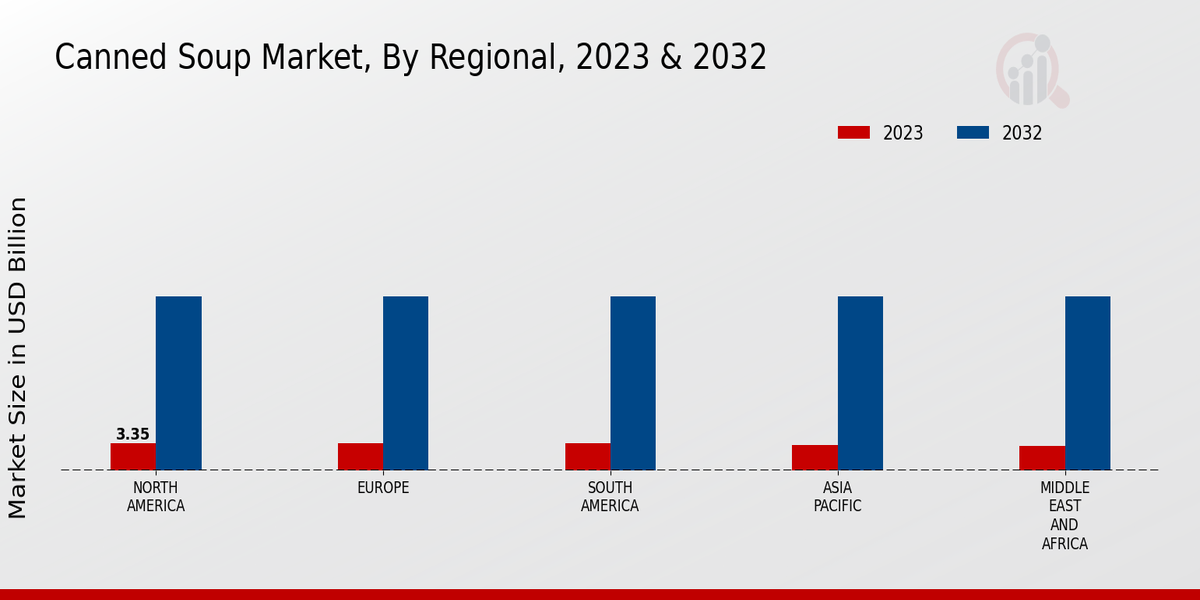Global Carmine Market Overview
Carmine Market Size was estimated at 102.28 (USD Billion) in 2023.The Carmine Industry is expected to grow from 0.05 (USD Billion) in 2024 to 0.08 (USD Billion) by 2032. The Carmine Market CAGR (growth rate) is expected to be around 6.14% during the forecast period (2024 - 2032).

Source: Primary Research, Secondary Research, MRFR Database and Analyst Review
Key Carmine Market Trends Highlighted
Key market drivers for the Carmine Market include the growing demand for natural food colorants in the food and beverage industry, increasing consumer preference for natural and organic ingredients, and rising awareness of synthetic colorants' potential health risks. Opportunities for exploration and capture lie in the expansion of applications in pharmaceuticals, cosmetics, and textiles, as well as the development of innovative extraction and production technologies. Recent trends in the carmine market indicate a shift towards sustainable and eco-friendly production practices. Consumers are increasingly seeking products derived from natural and renewable sources, leading to a growing demand for carmine extracted from insects. Furthermore, advancements in biotechnology and genetic engineering hold potential for cost-effective production and increased availability of carmine in the future, further boosting market growth.
Carmine Market Drivers
- Growing Demand for Carmine in the Food Industry
Carmine is a natural red pigment obtained from the cochineal insect. It is extensively used in the food and cosmetic industries to enhance the color of different products. The demand for carmine is expected to increase due to the growing need for naturally sourced and colored food products. The unique advantage of carmine is that it has a stable and vibrant red color. Carmine is one of these pigments that has very high stability and does not disappear as soon as the pH or conditions in food processing change.Thus, the ever-increasing population, which is health-concerned, and the manufacturers, who prefer to produce naturally sourced products, can guarantee a rise in the demand for carmine, its global market, being.
Expansion of the Pharmaceutical and Cosmetic Industries
Moreover, in the pharmaceutical and cosmetic industries, carmine has been used, which is increasing the growth of the Carmine Market. In pharmaceuticals, it is useful to color the tablets, capsules, and others. The rising pharmaceutical industry, mainly in emerging markets, will increase the demand for the carmine. In cosmetics, it is used in lipsticks, blushes, and others which give a natural red color. The growing cosmetic industry, mainly in Asia-Pacific, will increase demand for the Carmine Market Industry.
Rising Popularity of Carmine as a Natural Alternative to Synthetic Colors
Artificial colors have been largely used across all industries. However, the increased attention to its potential negative impact on health has caused the upraise for the use of natural ones instead. As a result, Carmine, which is known as a natural pigment, remains in demand due to its ability to provide a vivid red color without the potentially damaging effect that synthetic dyes might have. With the consistent rise in the awareness level of customers regarding the advantages of natural products, the demand for Carmine will experience growth as well.Thus, while the use of synthetic colorants lacks sustainability and has a significantly damaging effect on the environment, the market for natural coloring solutions seems to be expanding.
Carmine Market Segment Insights
Carmine Market Grade Insights
The Carmine Market is segmented based on Grade into Technical Grade, Pigment Grade and Food Grade. The use of pigment Grade carmine in cosmetics, paints and inks in different end-user industries is expected to be the most prominent segment in 2023.
The demand for carmine in the pharmaceutical industry’s Technical Grade, as it is beneficial for medicinal applications and used in the production of pharmaceutical gelatin, is forecasted to have the highest growth rate during the forecast period. However, Food Grade carmine, which is used as a critical ingredient in food and beverage, is expected to grow at a steady pace, which is followed by the pharmaceutical and Technical Grade segment.The increasing demand for carmine from cosmetics, food and beverages and pharmaceuticals among end user industries is expected to be the primary factor responsible for the growth of this market.
The market is also expected to be driven by other factors such as the growing popularity of natural and safe characteristics of carmine among consumers. Key players in the Carmine Market are D.D. Williamson, Sensient Technologies Corporation, Chr. Hansen Holding A/S, Archer Daniels Midland Company and Kalsec Inc. These companies are concentrating on increasing their production capacities and launching new products as per the increasing demand for these dyes.

Source: Primary Research, Secondary Research, MRFR Database and Analyst Review
Carmine Market Application Insights
The Carmine Market is classified based on application into Food and Beverage, Cosmetics and Personal Care, Pharmaceuticals, Textiles, Paints and Coatings, and Inks. The Food and Beverage segment held the largest share in the Carmine Market in 2023, and the trend is expected to continue over the forecast period. Carmine is used extensively in food and beverages as a natural coloring agent, and it is used in productions covering a wide range of products. The Cosmetics and Personal Care segment is anticipated to register the highest CAGR over the forecast period due to the rising preference for natural and organic personal care products.
The Pharmaceuticals segment is also projected to drive the growth of the Carmine Market due to their usage in the production of drugs and supplements. The Textiles segment is expected to register steady growth due to the increasing demand for natural dyes in textiles. The Paints and Coatings segment is also projected to grow due to the growing perforation of natural pigments in paints and coatings. The Inks segment is expected to grow at a moderate pace in the forecast period due to the use of natural inks in the printing industry.
Carmine Market Source Insights
The Source segment of the Carmine Market can be classified into Cochineal Insects, Synthetic, and Natural. The Cochineal Insects segment held the largest market share in 2023, accounting for nearly half of the Carmine Market revenue. This is primarily due to the fact that cochineal insects are the traditional source of carmine, and they produce a high-quality pigment with excellent colorfastness. However, the Synthetic segment is expected to grow at a faster CAGR over the forecast period (2024-2032) due to the increasing demand for cost-effective and sustainable alternatives to cochineal-based carmine.The Natural segment is also expected to witness steady growth as consumers become more aware of the benefits of natural ingredients.
Carmine Market Form Insights
Liquid carmine is the most popular form, accounting for over 50% of the market share. This is due to its ease of use and versatility. Powdered carmine is also widely used, particularly in the food and beverage industry. Paste carmine is less common but offers a more intense color. The market growth for the Form segment is driven by the increasing demand for natural colors in food, beverages, and cosmetics.
Carmine Market End-Use Industry Insights
The Carmine Market is segmented into various end-use industries, including Food and Beverage, Pharmaceuticals, Cosmetics and Personal Care, Textiles, Paper and Packaging, and Automotive. Each segment holds a unique share of the market, contributing to its overall growth. The Food and Beverage industry dominates the Carmine Market, utilizing carmine as a natural colorant in products like beverages, confectionery, and dairy items. In 2023, this segment accounted for approximately 45% of the market revenue.
The Pharmaceuticals industry holds a significant share, employing carmine in the production of capsules, tablets, and other dosage forms.It accounted for around 20% of the market revenue in 2023. The Cosmetics and Personal Care industry leverages carmine's coloring properties in lipsticks, blushes, and other cosmetic products. This segment is expected to grow steadily, reaching a valuation of USD 10.5 billion by 2032. The textile industry utilizes carmine for dyeing fabrics, particularly in the production of high-end garments and textiles. It is projected to reach a valuation of USD 8.7 billion by 2032. The Paper and Packaging industry employs carmine in the production of specialty papers and packaging materials.Its market value is estimated to reach USD 7.9 billion by 2032. The Automotive industry utilizes carmine in the production of paints and coatings for vehicles. Its market value is forecasted to reach USD 6.3 billion by 2032.
Carmine Market Regional Insights
The Regional segment of the Carmine Market is expected to grow significantly over the forecast period. In 2023, North America held the largest market share, accounting for around 35% of the global market revenue. Europe and APAC are also expected to witness significant growth, with Europe expected to reach a valuation of USD 26.4 billion by 2032, and APAC expected to reach USD 38.5 billion by the same year. South America and MEA are expected to contribute to the overall growth of the regional segment, with MEA expected to reach a valuation of USD 6.2 billion by 2032.These regional insights provide valuable data for businesses operating in the Carmine Market, enabling them to make informed decisions and target specific geographic areas for growth and expansion.

Source: Primary Research, Secondary Research, MRFR Database and Analyst Review
Carmine Market Key Players And Competitive Insights
The Carmine Market's major players are changing the industry dynamics by adopting cutting-edge technologies and entering into strategic partnerships. Several major carmine players invest in research and development to introduce an array of products and services that suffice the varying requirements of customers on the global platform. The competitive scenario of the market is all set to change with major players entering the market arena, M occurring between companies for enriching product portfolios.
The key player in the carmine market is DDW The Colour House. It has manufacturing units at multiple locations and boasts a strong world presence footprint. Its major products are natural carmine and synthetic carmine and are used in food, beverage, cosmetic and pharmaceutical applications. ETHICS, a global bio-measurement organization for profiling, certifying and evaluating the sustainability of natural colors, is part of DDW's “Colors from Nature” portfolio. Due to the increasing consciousness of people towards the environment and natural changes, such steps are responsibly accepted by the people.Another major carmine market player is Sensient Technologies Corporation. Among many other natural carmine and synthetic carmine, it is well-known for its carmine product. Sensient’s natural carmine is truly natural and is extracted from the cochineal pupae and possesses kosher and halal certifications. The synthetic version of Sentiol carmines is synthetic and Uniform Europe certification. P around the world and present in more than 100 countries, are able to service and offer an extensive range of high quality and creative flavor and color solutions and food and beverage worldwide through their strong distribution network.
Key Companies in the Carmine Market Include
- Hansen
- I. du Pont de Nemours and Company
- Moriond
- FMC Corporation
- Naturex
- Neelikon Food Colours
- Natural Products
- Archer Daniels Midland Company
- Natural Food Colours
- Sensient Technologies
- DDW The Color House
- Roha Dyechem
Carmine Market Industry Developments
The Carmine Market is expected to reach USD 132.2 billion by 2032, exhibiting a CAGR of 2.6% during the forecast period. The market growth is primarily driven by the increasing demand for natural and safe colorants in various industries, including food, beverages, cosmetics, and pharmaceuticals. The rising consumer awareness regarding the harmful effects of synthetic dyes is further propelling the demand for carmine, a natural colorant derived from the cochineal insect.Recent news developments in the Carmine Market include the strategic partnership between Cargill and Chr. Hansen to expand their production capacity and meet the growing demand for natural colorants. Additionally, the acquisition of DD Williamson by Archer Daniels Midland Company has strengthened the supply chain and distribution network for Carmine in the global market.
Carmine Market Segmentation Insights
- Carmine Market Grade Outlook
- Technical Grade
- Pigment Grade
- Food Grade
- Carmine Market Application Outlook
- Food and Beverage
- Cosmetics and Personal Care
- Pharmaceuticals
- Textiles
- Paints and Coatings
- Inks
- Carmine Market Source Outlook
- Cochineal Insects
- Synthetic
- Natural
- Carmine Market Form Outlook
- Carmine Market End-Use Industry Outlook
- Food and Beverage
- Pharmaceuticals
- Cosmetics and Personal Care
- Textiles
- Paper and Packaging
- Automotive
| Report Attribute/Metric |
Details |
| Market Size 2023 |
102.28 (USD Billion) |
| Market Size 2024 |
0.05 (USD Billion) |
| Market Size 2032 |
0.08 (USD Billion) |
| Compound Annual Growth Rate (CAGR) |
6.14% (2024 - 2032) |
| Report Coverage |
Revenue Forecast, Competitive Landscape, Growth Factors, and Trends |
| Base Year |
2023 |
| Market Forecast Period |
2024 - 2032 |
| Historical Data |
2019 - 2023 |
| Market Forecast Units |
USD Billion |
| Key Companies Profiled |
Chr. Hansen, E. I. du Pont de Nemours and Company, Moriond, FMC Corporation, Naturex, Neelikon Food Colours, Natural Products, Archer Daniels Midland Company, Natural Food Colours, Sensient Technologies, DDW The Color House, Roha Dyechem |
| Segments Covered |
Grade, Application, Source, Form, End-Use Industry, Regional |
| Key Market Opportunities |
Natural and Sustainable Ingredients Demand for natural and sustainable food additives Growing Health Consciousness Increasing consumer awareness of the health benefits of carmine Expansion in Food and Beverage Growing use of carmine in various food and beverage applications Pharmaceutical and Cosmetic Applications Potential for carmine in pharmaceuticals and cosmetics |
| Key Market Dynamics |
1 Rising demand for natural food colorants2 Increasing awareness of health benefits3 Technological advancements in extraction and purification4 Growing adoption in the food and beverage industry5 Expansion of application areas in cosmetics and pharmaceuticals |
| Countries Covered |
North America, Europe, APAC, South America, MEA |
Frequently Asked Questions (FAQ) :
The overall valuation of the Carmine Market in 2023 is estimated to be around 102.28 billion USD. It is projected to reach approximately 0.08 billion USD by 2032, growing at a CAGR of 6.14% between 2024 and 2032.
Currently, the Asia Pacific region dominates the Carmine Market, accounting for a majority of the market share. This dominance is primarily attributed to the increasing demand for carmine in various industries, such as food, cosmetics, and pharmaceuticals, in countries like China, India, and Japan.
Carmine finds applications in a wide range of industries. In the food industry, it is used as a natural coloring agent in products such as beverages, confectionery, and dairy products. In the cosmetic industry, it is utilized in lipsticks, blushes, and other makeup products. Additionally, carmine is employed in the pharmaceutical industry for coloring medications and in the textile industry for dyeing fabrics.
Some of the major players in the Carmine Market include D.D. Williamson, Food Ingredient Solutions, Inc., Kalsec, Inc., Sensient Technologies Corporation, and Chr. Hansen Holding A/S. These companies hold a substantial market share and compete based on factors such as product quality, innovation, and geographical reach.
Several factors contribute to the growth of the Carmine Market. Rising consumer demand for natural and clean-label food and cosmetic products is a significant driver. Additionally, the growing pharmaceutical industry and increasing application of carmine in various industries, such as textiles and printing inks, are expected to propel market growth in the coming years.
The Carmine Market faces certain challenges that may hinder its growth. The availability of synthetic alternatives, such as cochineal extract, and stringent regulations regarding the use of carmine in some regions pose challenges to market expansion. Additionally, fluctuations in the prices of raw materials used in carmine production can impact the overall market dynamics.
The Carmine Market is expected to witness several trends in the coming years. The growing demand for organic and sustainable products is likely to boost the market for natural colorings like carmine. Furthermore, advancements in extraction and production technologies are anticipated to enhance the efficiency and cost-effectiveness of carmine production, contributing to market growth.
The Carmine Market is projected to maintain a steady growth trajectory in the coming years. It is estimated to grow at a CAGR of approximately 6.14% from 2024 to 2032. This growth is driven by increasing demand from various industries, coupled with ongoing product innovations and expanding applications.
The Carmine Market is segmented into several key regions, including North America, Europe, Asia Pacific, Latin America, and the Middle East Africa. Asia Pacific currently holds the largest market share, followed by Europe and North America. Emerging markets in Asia Pacific, such as China and India, are expected to drive regional growth due to rising disposable incomes and increasing demand for natural colorings in food and cosmetics.
Carmine has the potential for exciting new applications in various industries beyond its traditional uses. In the food industry, it could be explored as a natural coloring agent in plant-based meat alternatives and functional foods. In the cosmetic industry, carmine could be utilized in developing innovative makeup products with long-lasting and smudge-proof properties. Additionally, research is ongoing to investigate the use of carmine in biomedical applications, such as drug delivery and tissue engineering.

















